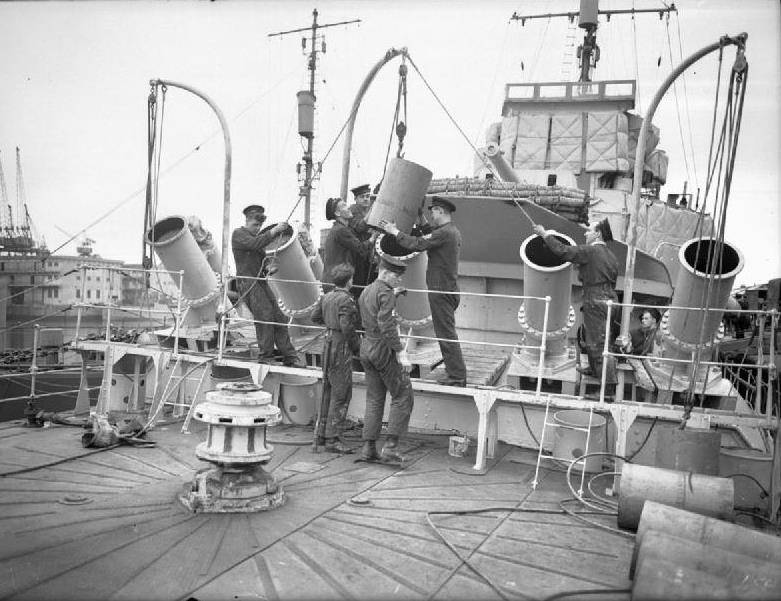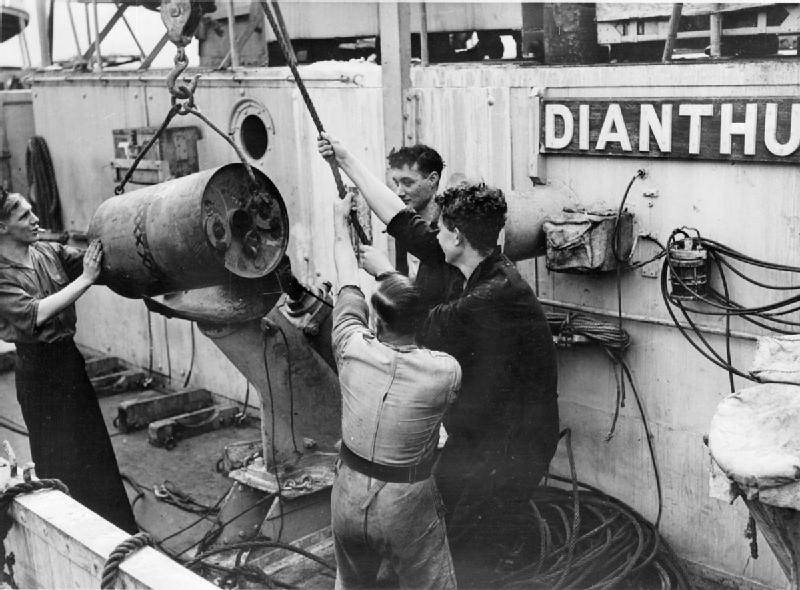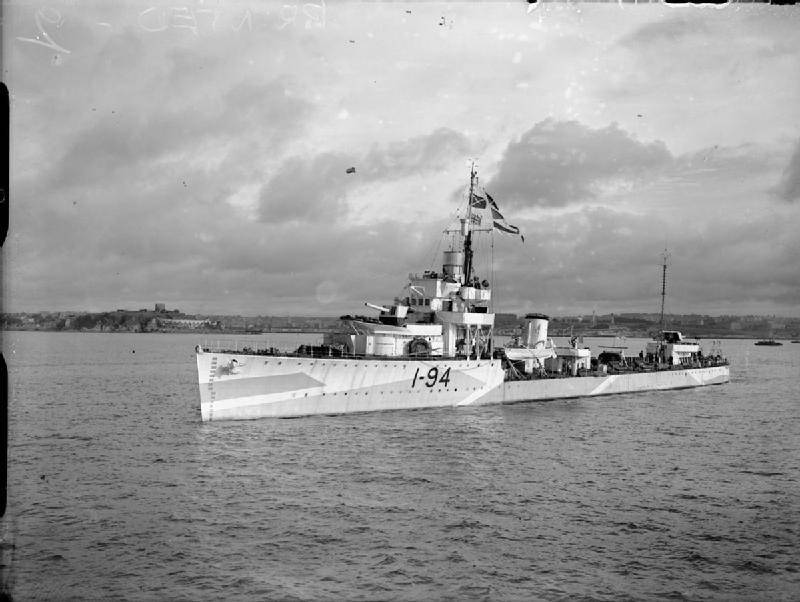Anti-submarine bombers Fairlie Mortar and Thornycroft Mortar
History The program to develop anti-submarine systems Fairlie Mortar dates back to the late thirties. In 1939, the organization ASW research group (“Anti-Submarine Defense Research Group”), which worked in the town of Fearley, was tasked to compare different options for anti-submarine systems. It was necessary to determine which weapon more efficient: one large depth charge with a mass of 1600 pounds (726,4 kg) or a large number of 25-pound (11,35 kg) ammunition. Taking into account the results of these studies, it was planned to choose further paths for the development of anti-submarine weapons.
Tests have shown that a heavy depth charge is guaranteed to hit a conditional submarine, even with a significant miss, but rather difficult to operate. A significant number of smaller ammunition made it possible to combine the acceptable power of the warhead with a sufficient probability of hitting the target. As a result, the development of heavy bombs was abandoned in favor of products of small and medium weight.

Thornycroft Mortar bomber on the deck of the destroyer HMS Whitehall (I94), 27 July 1941.
Depth bombs of comparatively low mass could be sent to the target with the help of special launching devices and thereby increase the firing range. Already at the beginning of 1940, the military department issued a new technical task for the creation of advanced anti-submarine weapons. The military wanted an anti-submarine bombard capable of firing several ammunition with a sufficient payload in one volley. Specific features of the technical appearance of such weapons should be determined in the course of subsequent work.
In accordance with the name of the city where the PLO Research Group was located, and taking into account the optimal appearance of the bomb bomb, the new project received the working designation Fairlie Mortar - “Mortira Furley”. Subsequently, one of the developments of this program, developing existing ideas, was named Thornycroft Mortar ("Mortar Thornycroft") - by the name of the company-developer. Bombers also received some unofficial nicknames.
According to reports, the anti-submarine defense specialists quickly decided on the ammunition for the new bombs. This weapon was supposed to attack targets with the help of Mark VII series depth charges. In the basic version, adopted in service in the late thirties, such a bomb had a cylindrical body with thin walls and a nest for installing a hydrostatic fuse. With a total mass of 420 pounds (191 kg), the bomb carried 290 pounds (132 kg) of TNT. She could dive at speeds up to 3 m / s. The fuse worked at a predetermined depth, which should not exceed 300 feet (91 m).
The first advanced weapons project was developed by the staff of the ASW research group. At the same time, they were forced to resort to the help of designers from Vickers-Armstrong. Together, the military and the staff of a private company formed the overall look of the weapon and worked out the various features of its design.
The project, which resulted from the joint work of Vickers-Armstrong and the PLO Group, proposed the use of two unified launchers at once. These devices were suggested to be mounted on the tank and the ship's poop, or on the sides of the superstructure. The specific configuration of anti-submarine weapons could be determined in accordance with the characteristics of the carrier.
The basis of the Fairlie Mortar bomb was supposed to be a fixed platform with mounts for the artillery unit. The latter was a clip with five large trunks. To compensate for the rolling motion, the yoke could move around the longitudinal axis, maintaining the desired position of the barrels. The yoke was also completed with an uncomplicated stabilizer, reducing the negative impact of pitching. A similar design will later be used in new projects.
The launch of the Mark VII depth bombs was proposed to be carried out with the help of five shafts of short length. The trunks did not have rifling and had to be charged from the barrel. Five trunks should be firmly fixed in a common holder with a fixed angle of elevation. According to some reports, they could be located with a slight inclination relative to the longitudinal vertical plane. In this case, a small dilution of departing bombs was provided. The lateral inclination of ten barrels in two installations should be determined so that the points of incidence of the bombs formed a circle.
Next to the two launchers, it was necessary to mount the storage and supply of ammunition, as well as lightweight cranes for loading bombs. In preparing the “Mortyra Furley” for firing, it was necessary to raise ammunition to a great height, and this required appropriate technical means.
Soon after the start of the Fairlie Mortar project, an alternative proposal appeared. Private shipbuilding firm John I. Thornycroft & Company has begun to develop its own anti-submarine bomb launcher for existing ammunition. This project received the designation Thornycroft Mortar. In addition, it was called the Long-range deep charge thrower ("Long-range depth charge launcher"). For its characteristic appearance, the prototype was nicknamed Five Wide Virgins ("Five fat virgins").
As is clear from the unofficial name of the project, Thornycroft experts suggested using only one launcher with five trunks. On the deck of the ship should have mounted a reinforced rectangular platform on which it was proposed to install the bombers themselves. The latter consisted of five separate trunks mounted motionless. This method of installation did not impose special requirements on the strength of the ship, but excluded the use of any means of stabilization.

Sailors ship depth bomb type Mk VII
Each of the five elements of the Thornycroft Mortar bomb bomb consisted of three main units. The first is a rectangular platform with longitudinal bars to support the deck. Immediately on the platform with a large number of bolts fastened breech, made in the form of a short inclined pipe with a triangular strut. Also bolted to the breech should be attached to a longer muzzle of the barrel. On the supporting platform provided for the installation of an electrical system ignition propellant charge. The barrel was rigidly fixed with an angle of elevation 50 °, providing the maximum range of the shot.
It was proposed to attack the target using the Mark VII standard depth bomb carrying an 132 kg of TNT. The launch of this munition was supposed to be carried out by a propelling charge of cordite mass 16 ounces (453,6 g). According to calculations, such a charge could send a bomb at a distance of 330 yards (300 m).
Five "Fat Virgins" should be installed on one line perpendicular to the longitudinal axis of the carrier. To increase the area of fire, individual trunks could be mounted at a small angle to each other. Near the five-barreled anti-submarine complex should be located volumes for storage of ammunition. He also needed cranes to load bombs into barrels. The prototype of the Long-range deep charge thrower was supplemented with three taps at once.
Two projects proposed naval specialists and a private company were studied by the command. For a number of reasons, based on the results of such an analysis, a project from designers John I. Thornycroft & Company was recommended for construction and testing. The Fairlie Mortar bomb, created by military engineers, in turn, did not receive development. In its original form, this project did not reach practical implementation, but later it had a noticeable impact on the further development of anti-submarine weapons in Great Britain and other countries.
In the first months of the 1941, the first Mortar Thornycroft was manufactured. The prototype was designed for installation on the destroyer HMS Whitehall (I94). This ship, previously sent to the reserve and returned to service in the 1939 year, carried not the most powerful weapons, and an experienced bomber could significantly increase its combat effectiveness. A platform with five trunks was placed on the tank, in front of the superstructure. After such a modernization, the destroyer could both fire at the enemy's submarine and send bombs to it in the “traditional” way, using a pair of stern throwers.
There are fragmentary information about the involvement in the testing of the second ship. According to them, in 1942, the carrier of the Thornycroft Mortar system became the destroyer HMS Diana. It is reported that a bomber was installed on this ship in a reduced configuration - with four barrels. However, in this case there is a certain error, since the specified ship could not become an experimental vessel.
The destroyer Diana (H49), received by the British fleet in 1932, in September 1940 was transferred to Canada, which gave it the new name HMCS Margaree. Just a few weeks later, on October 17 of the same year, the destroyer set off on the march as part of the OL8 convoy cover. October 22 300 miles west of Ireland destroyer collided with transport MV Port Fairy. The vessel with the cargo was damaged, but was able to continue sailing. The warship sank. The crew of the HMCS Margaree consisted of a 176 man. 34 sailors were rescued by colleagues from transport; the rest are dead or missing. Thus, the destroyer “Diana” / “Marjorie” by definition could not become an experimental vessel and participate in the 1942 trials of the year.
Most likely, the destroyer Whitehall remained the sole carrier of the Long-range deep charge thrower from Thornycroft. Short-term tests conducted by his crew showed that the new weapon is unsuitable for practical operation, and can also be dangerous not only for enemy submarines, but also for its own carrier.
It was immediately established that the Five Wide Virgins system is extremely inconvenient from the point of view of preparation for firing. Full reloading of a bombet required eight people to work together and took about 10 minutes. After a single volley on the target, the ship for 10 minutes lost its ability to perform a second attack. During this time, the situation could change, and therefore the bomb was not fully satisfied with the military.
However, prolonged recharging was not the biggest problem. As it turned out, 450-gram cord cordite accelerated depth charge to low speeds. The projectile left the barrel and flew to a predetermined range, but the flight to the crash site and the exit to a predetermined depth of detonation took too much time. Because of this, a ship moving even at medium speed risked being dangerously close to exploding bombs and getting some kind of damage. Soon several attempts were made to correct this shortcoming of the “Mortarine Thornycroft”.

Destroyer HMS Whitehall (I94) shortly before the installation of "Mortarine Thornycroft"
An obvious solution to the problem was to increase the propellant charge, but this turned out to be impossible. Not a single British ship of that time would have withstood the increased returns. For this reason, it was decided to change the design of the bomb. The existing cylindrical body of the Mark VII product was supplemented with tail stabilizers, as a result of which the length of the bomb increased to 1,4 m.
The testers fired just three shots with such bombs. It turned out that the updated ammunition can fly a distance of about 330 m, but this does not solve all the problems. A larger bomb was less convenient to operate. It took up more space, and its loading into the barrel was very complex. There were problems with shooting. With the explosion of the propellant charge and launch the bomb shell and stabilizer received noticeable damage, worsening their aerodynamics. This led to the risk of deviation from a given trajectory, including with a premature fall. The meeting of the water bomb, now taking place at high speeds, led to new damage to the hull, which, among other things, could damage the fuse.
According to the analysis of the Fairlie Mortar project and the Thornycroft Mortar system tests, certain conclusions were drawn and a negative decision was made. The fleet still needed effective anti-submarine weapons, but the proposed bomb bomb had a lot of flaws and therefore had no interest for it.
By this time, the organization of the Department of Miscellaneous Weapons Development (Department of the development of various weapons) was involved in the work on the subject of bomb bomb. Its experts took into account the existing experience and proposed to build a new anti-submarine complex based on the principle of launching bombs. The basis of the launcher was supposed to be a stabilized platform with a large number of rod-guides. The stabilizer was proposed to borrow from the "Mortyra Furley."
The further development of this proposal, carried out with the application of some already known ideas and solutions, soon led to the appearance of the Hedgehog bomb bomb. Unlike his unsuccessful predecessors, he successfully coped with the trials, went into the series and became a regular weapon of a significant number of ships.
Mortar "Thornycroft" did not pass the test, and the project "Furley" did not even reach the construction of a prototype. However, the main ideas of these projects were not forgotten. So, the product Fairlie Mortar "shared" with the newer bombers means of stabilizing the launcher. In addition, some of the ideas of the two projects were later used to create new weapons of this class, and in this form came to practical use. First, the British fleet, and then the naval forces of other countries were able to get an effective and easy-to-use means of dealing with enemy submarines.
Based on:
http://navweaps.com/
http://uboat.net/
http://naval-history.net/
Friedman N. British Destroyers & Frigates: The Second World War & After. Seaforth Publishing. 2002.
Information